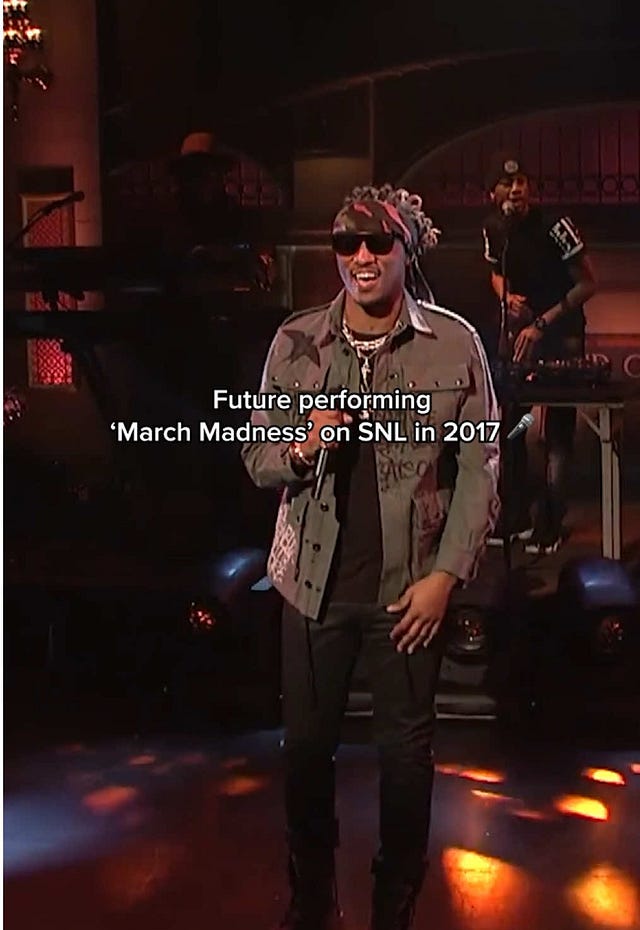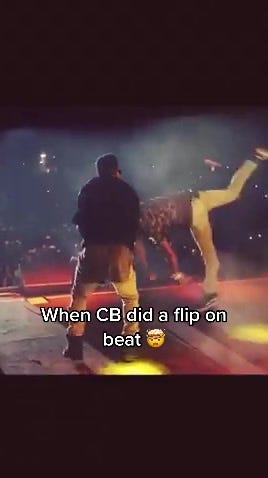Every year on March 1st, Future fans on social media say one of two things:
“It’s that time of year again.”
and
“Stand for our national anthem.”
The anthem they speak of is a song that came out 10 years ago during Future’s scorching hot run that culminated in the release of the album DS2 (Dirty Sprite 2).
The year DS2 dropped, Future released 3 mixtapes: Monster, Beast Mode, and the widely revered classic 56 Nights, and the standout song on 56 Nights sees an increase in streams every year around this time. That song is called:
MARCH MADNESS.
It’s no coincidence that when Spotify dropped their “Greatest Songs of the Streaming Era” list last year, March Madness was No. 5, or that fans and publications alike love the record.
March Madness is a staple in Future’s catalog that presents an interesting case study of cultural rituals and the anchoring effect.
In today's context, a cultural ritual can be considered a repeated practice that reinforces shared traditions, values, and community identity.
Cultural rituals form over time and have mystical power. This power helps create mental availability, awareness and consideration — all of which brands can leverage if they tap into it at the right time.
Whether knowingly or unknowingly, Future taps into this phenomenon in a few ways.
THE CAUSES OF MARCH MADNESS
This song came at a tipping point in Future’s career. His sophomore album, Honest, was met with a lukewarm reception, he was fresh off a breakup, and questions were beginning to loom about his long-term legacy.
In the face of that, Future dropped hit after hit. March Madness unexpectedly blew up, and now stands the test of time as a quintessential Future record.
The causes of March Madness’ long-term impact can be boiled down to a psychological concept called the Anchoring Effect.
By definition, the Anchoring Effect is a cognitive bias characterized by the common human tendency to rely too heavily on the first piece of information (the “anchor”) when making decisions.
The thing is, when light listeners and heavy listeners alike were exposed to March Madness, the anchoring effect triggered them in two ways:
I. Temporal Anchoring
March Madness started out as a record, but each year, it has continued to evolve into a celebration that fosters community online through shared experiences and memories of its original release.
It’s a form of anchoring that is not concerned with price but rather an already established date and time of celebration. In that way it lodges itself in the minds of consumers.
When you consider it, the song’s success mirrors the success of some of the world’s biggest brands. More specifically, it mirrors the brands have created events or moments that are now cultural touchstones that strengthen consumers' emotional connections to the brand.
For example, Apple leverages a form of anchoring with Apple Day.
People generally know that Apple will give a keynote speech twice a year, during which they will announce the release dates of their new products.
Similarly, Future lets you know that on March 1st, it’s time to relive the magic of 2015. Click the video and the comments on the TikTok below if you don’t believe me:
II. Event Anchoring
Many casual listeners who might be hearing Future for the first time were likely exposed to March Madness during… March Madness.
Dropping a song that coincides with the NCAA’s biggest moment allowed Future to reap the benefits of that association as well. Whether intentional or not.
As evidenced by the Google Trends data below, for the past five years at least, there have been spikes in search traffic for Future’s song March Madness, and with that, it’s safe to say his streams have increased.
In the context of Anchoring, for casual fans of Future, March Madness is likely the first bit of “information” that they were truly receptive too about him, and if the interaction is positive (i.e. they rock with the song), that’s the type of cognitive bias that will get the check out his other work.
THE EFFECTS OF MARCH MADNESS
Knowing what’s caused March Madness to become a cultural ritual for Future, the effects have manifested in a few ways, but I think the most important one is
An Increase in Mental Availability.
The world is unbelievably noisy, but Future has managed to create an emotional connection that helps him cut through the static every March—one that he can continue leveraging years from now.
Each year, the same memes, links, and jokes remind people of 2015, when they were in high school or college, listening to 56 Nights for the first time and hearing about March Madness.
 Tiktok failed to load.
Tiktok failed to load.Enable 3rd party cookies or use another browser
The Google trends photo above also speaks to this, but consider the memes that circulate every year during March Madness.
THE TAKEAWAY FOR BRANDS
Just as Future anchored a piece of his identity to March, brands can identify specific times of the year and create campaigns or pulse moments that not only capture attention during that window but also serve as an anchor to their overall identity.
Doing so might require thinking beyond one-off transactions with consumers (or the semi-regular ones, depending on how often they shop with you), but it pays dividends in the long run in the form of cultural cache.
Lastly, create immersive experiences or interactive campaigns that invite your base to participate in a cultural ritual like the celebration of this particular song during this particular month. On one hand, it helps build community online, which can go a long way over time & on the other hand, it might generate some awareness/consideration (if not lead to sales) for the business.
EPILOGUE
March Madness is just one example of the power of cultural rituals in hip-hop. And No, I’m not talking about the type of rituals that some random person described in their YouTube conspiracy video about “The Elites.” I’m talking about the rituals that are part of the fabric of human existence.
While most brands don’t have the flexibility that an artist does to name a song after a hugely popular event and reap the benefits, this is still a good case study that speaks volumes.
March Madness is up there in the pantheon with songs like Swag Surfin’ — it’s bigger than the moment it was released, and for good reason.
Listen and see what the hype is all about or dress it up and go to Nassau. Whichever you prefer.
One.












Legendary. Loved the way you brought in event and temporal anchoring. As a proud Future fan, this one hit home!
So essentially, Future is the Mariah Carey for college basketball in March 😂